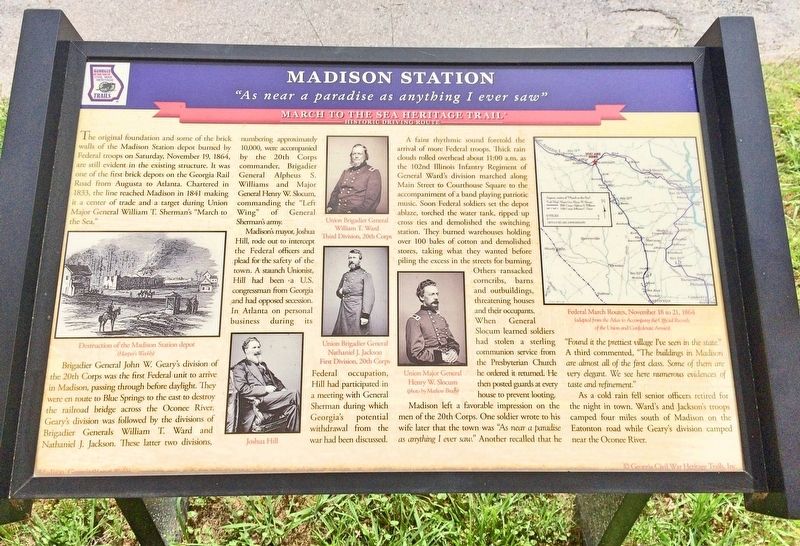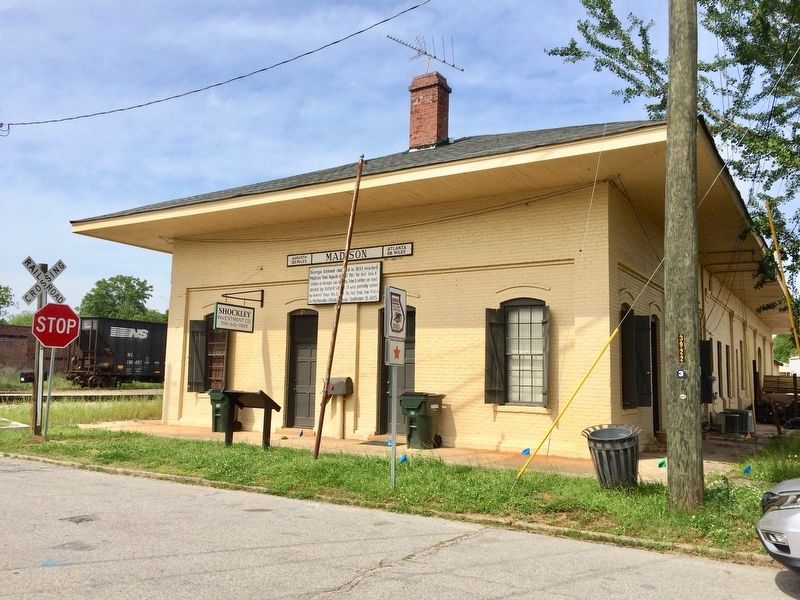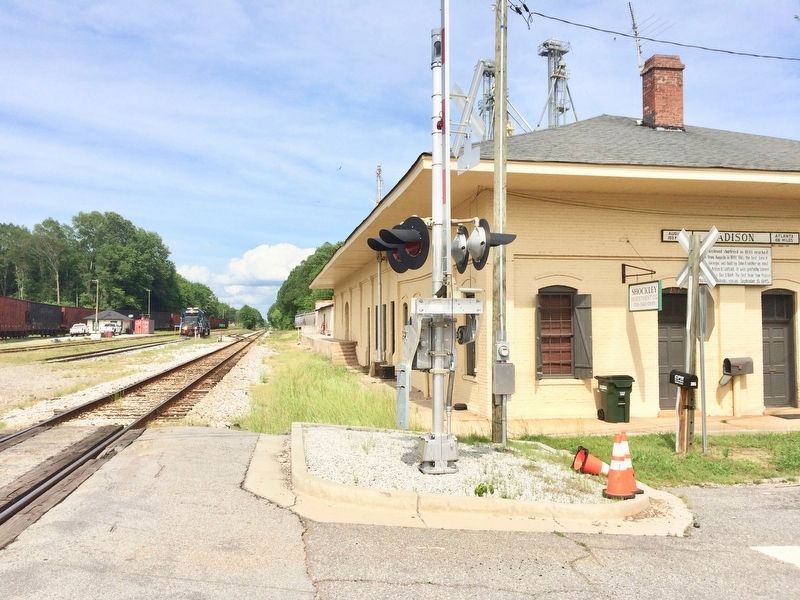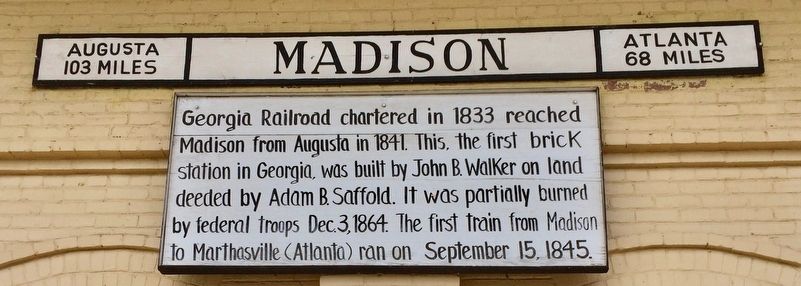Madison in Morgan County, Georgia — The American South (South Atlantic)
Madison Station
"As near a paradise as anything I ever saw"
— March to the Sea Heritage Trail —
The original foundation and some of the brick walls of the Madison Depot burned by Federal troops on Saturday, November 19, 1864, are still evident in the existing structure. It was one of the first brick depots on the Georgia Rail Road from Augusta to Atlanta. Chartered in 1833, the line reached Madison in 1841 making it a center of trade and a target during Union Major General William T. Sherman's "March to the Sea."
Brigadier General John W. Geary's division of the 20th Corps was the first Federal unit to arrive in Madison, passing through before daylight. They were en route to Blue Springs to the east to destroy the railroad bridge across the Oconee River. Geary's division was followed by the divisions of Brigadier Generals William T. Ward and Nathaniel J. Jackson. These latter two divisions, numbering approximately 10,000, were accompanied by the 20th Corps commander, Brigadier General Alpheus S. Williams and Major General Henry W. Slocum, commanding the "Left Wing" of General Sherman's army.
Madison's mayor, Joshua Hill, rode out to intercept the Federal officers and plead for the safety of the town. A staunch A faint rhythmic sound foretold the arrival of more Federal troops. Thick rain clouds rolled overhead about 11:00 a.m. as the 102nd Illinois Infantry Regiment of General Ward's division marched along Main Street to Courthouse Square to the accompaniment of a band playing patriotic music. Soon Federal soldiers set the depot ablaze, torched the water tank, ripped up cross ties and demolished the switching station. They burned warehouses holding over 100 bales of cotton and demolished stores, taking what they wanted before piling the excess in the streets for burning. Others ransacked corncribs, barns and outbuildings, threatening houses and their occupants. When General Slocum learned soldiers had stolen a sterling communion service from the Presbyterian Church he ordered it returned. He then posted guards at every house to prevent looting.
Madison left a favorable impression on the men of the 20th Corps. One soldier wrote to his wife later that the town was "As near a paradise as anything I ever saw." Another recalled that he "Found it the prettiest village I've seen in the state." A third commented, "The buildings in Madison are almost all of the first class. Some of them are very elegant. We see here numerous evidences of taste and refinement."
As a cold rain fell senior officers retired for the night in town. Ward's and Jackson's troops camped four miles south of Madison on the Eatonton road while Geary's division camped near the Oconee River.
[Photo captions]
Left: Destruction of the Madison Station depot (Harper's Weekly)
Middle top: Union Brigadier General William T. Ward Third Division, 20th Corps
Middle: Union Brigadier General Nathaniel J. Jackson First Division, 20th Corps
Middle bottom: Joshua Hill
Union Major General Henry W. Slocum (photo by Mathew Brady) Top right: Federal March Routes, November 18 to 21, 1864
(adapted from the Atlas to Accompany the Official Records of the Union and Confederate Armies)
Background watermark: Madison, Georgia (Harper's Weekly) (Marker Number L10.)
Topics and series. This historical marker is listed in these topic lists: Bridges & Viaducts • Railroads & Streetcars • War, US Civil • Waterways & Vessels. In addition, it is included in the Sherman’s March to the Sea series list. A significant historical date for this entry is November 19, 1864.
Location. 33° 35.888′ N, 83° 28.203′ W. Marker is in Madison, Georgia, in Morgan County. Marker is on West Jefferson Street west of Thomason Road when traveling west. Touch for map. Marker is at or near this postal address: 287 West Jefferson Street, Madison GA 30650, United States of America. Touch for directions.
Other nearby markers. At least 8 other markers are within walking distance of this marker. Madison Train Station (here, next to this marker); The Town Park (about 400 feet away, measured in a direct line); Industrial Corridor (about 400 feet away); The Town Spring (about 600 feet away); Railroad Street Commerce (about 700 feet away); Freedom of Assembly (about 700 feet away); Reconstruction Property Rights (approx. 0.2 miles away); Lodging Establishments (approx. 0.2 miles away). Touch for a list and map of all markers in Madison.
Also see . . . The Town Sherman Refused to Burn. The Washington Post article; October 14, 1979 (Submitted on May 10, 2017, by Mark Hilton of Montgomery, Alabama.)
Credits. This page was last revised on February 17, 2021. It was originally submitted on May 10, 2017, by Mark Hilton of Montgomery, Alabama. This page has been viewed 539 times since then and 23 times this year. Photos: 1, 2, 3, 4. submitted on May 10, 2017, by Mark Hilton of Montgomery, Alabama.



